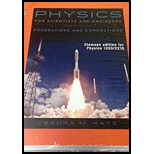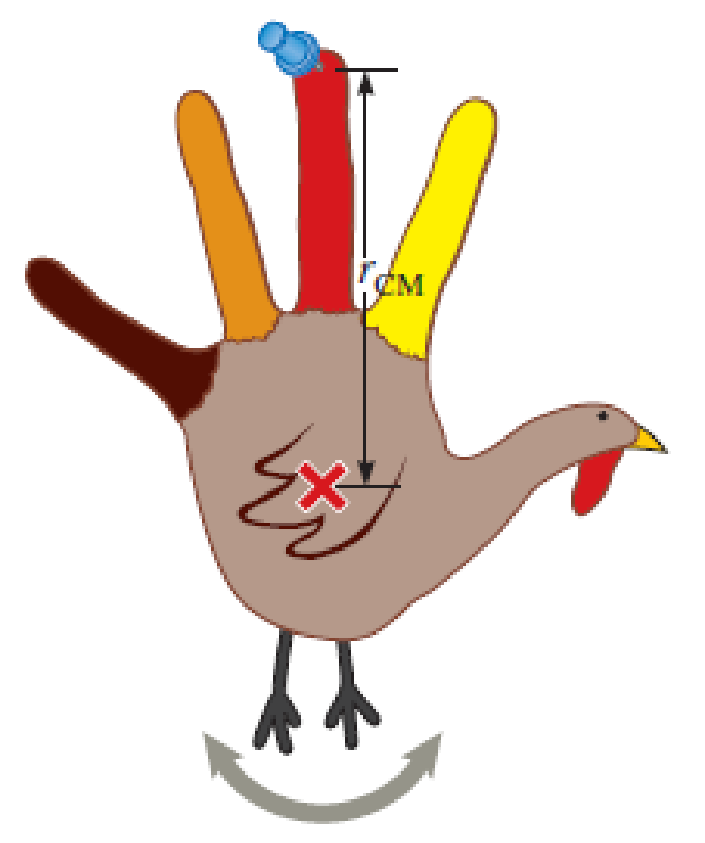
Physics for Scientists and Engineers: Foundations and Connections
15th Edition
ISBN: 9781305289963
Author: Debora M. Katz
Publisher: Cengage Custom Learning
expand_more
expand_more
format_list_bulleted
Concept explainers
Textbook Question
Chapter 16, Problem 36PQ
A child works on a project in art class and uses an outline of her hand on a sheet of construction paper to draw a turkey (Fig. P16.36). The teacher pins the turkey to the bulletin board in the front of the classroom by using a thumbtack. The student notices that if she flicks her finger on the end of the turkey, it oscillates back and forth with a frequency of about 1.65 Hz. If the rotational inertia of the paper turkey is 1.25 × 10−5 kg·m2 and its mass is 0.005 kg, what is the distance between the thumbtack and the center of mass of the turkey?

FIGURE P16.36
Expert Solution & Answer
Want to see the full answer?
Check out a sample textbook solution
Students have asked these similar questions
Using the Experimental Acceleration due to Gravity values from each data table, Data Tables 1, 2, and 3; determine the Standard Deviation, σ, mean, μ, variance, σ2 and the 95% Margin of Error (Confidence Level) Data: Ex. Acc. 1: 12.29 m/s^2. Ex. Acc. 2: 10.86 m/s^2, Ex. Acc. 3: 9.05 m/s^2
In the Super Smash Bros. games the character Yoshi’s has a “ground pound” down special move where he launches himself downward to attack an enemy beneath him. A) If Yoshi flings himself downwards at 9.76 miles per hour to hit an enemy 10.5 m below him, how fast is Yoshi traveling when he hits the enemy? 1 mile = 1609 m B) How much time does it take Yoshi to hit the enemy beneath him?
No chatgpt pls will upvote
Chapter 16 Solutions
Physics for Scientists and Engineers: Foundations and Connections
Ch. 16.1 - Prob. 16.1CECh. 16.2 - Prob. 16.2CECh. 16.2 - For each expression, identify the angular...Ch. 16.5 - Prob. 16.4CECh. 16.6 - Prob. 16.5CECh. 16.6 - Prob. 16.6CECh. 16 - Case Study For each velocity listed, state the...Ch. 16 - Case Study For each acceleration listed, state the...Ch. 16 - Prob. 3PQCh. 16 - Prob. 4PQ
Ch. 16 - Prob. 5PQCh. 16 - Prob. 6PQCh. 16 - The equation of motion of a simple harmonic...Ch. 16 - The expression x = 8.50 cos (2.40 t + /2)...Ch. 16 - A simple harmonic oscillator has amplitude A and...Ch. 16 - Prob. 10PQCh. 16 - A 1.50-kg mass is attached to a spring with spring...Ch. 16 - Prob. 12PQCh. 16 - Prob. 13PQCh. 16 - When the Earth passes a planet such as Mars, the...Ch. 16 - A point on the edge of a childs pinwheel is in...Ch. 16 - Prob. 16PQCh. 16 - Prob. 17PQCh. 16 - A jack-in-the-box undergoes simple harmonic motion...Ch. 16 - C, N A uniform plank of length L and mass M is...Ch. 16 - Prob. 20PQCh. 16 - A block of mass m = 5.94 kg is attached to a...Ch. 16 - A block of mass m rests on a frictionless,...Ch. 16 - It is important for astronauts in space to monitor...Ch. 16 - Prob. 24PQCh. 16 - A spring of mass ms and spring constant k is...Ch. 16 - In an undergraduate physics lab, a simple pendulum...Ch. 16 - A simple pendulum of length L hangs from the...Ch. 16 - We do not need the analogy in Equation 16.30 to...Ch. 16 - Prob. 29PQCh. 16 - Prob. 30PQCh. 16 - Prob. 31PQCh. 16 - Prob. 32PQCh. 16 - Prob. 33PQCh. 16 - Show that angular frequency of a physical pendulum...Ch. 16 - A uniform annular ring of mass m and inner and...Ch. 16 - A child works on a project in art class and uses...Ch. 16 - Prob. 37PQCh. 16 - Prob. 38PQCh. 16 - In the short story The Pit and the Pendulum by...Ch. 16 - Prob. 40PQCh. 16 - A restaurant manager has decorated his retro diner...Ch. 16 - Prob. 42PQCh. 16 - A wooden block (m = 0.600 kg) is connected to a...Ch. 16 - Prob. 44PQCh. 16 - Prob. 45PQCh. 16 - Prob. 46PQCh. 16 - Prob. 47PQCh. 16 - Prob. 48PQCh. 16 - A car of mass 2.00 103 kg is lowered by 1.50 cm...Ch. 16 - Prob. 50PQCh. 16 - Prob. 51PQCh. 16 - Prob. 52PQCh. 16 - Prob. 53PQCh. 16 - Prob. 54PQCh. 16 - Prob. 55PQCh. 16 - Prob. 56PQCh. 16 - Prob. 57PQCh. 16 - An ideal simple harmonic oscillator comprises a...Ch. 16 - Table P16.59 gives the position of a block...Ch. 16 - Use the position data for the block given in Table...Ch. 16 - Consider the position data for the block given in...Ch. 16 - Prob. 62PQCh. 16 - Prob. 63PQCh. 16 - Use the data in Table P16.59 for a block of mass m...Ch. 16 - Consider the data for a block of mass m = 0.250 kg...Ch. 16 - A mass on a spring undergoing simple harmonic...Ch. 16 - A particle initially located at the origin...Ch. 16 - Consider the system shown in Figure P16.68 as...Ch. 16 - Prob. 69PQCh. 16 - Prob. 70PQCh. 16 - Prob. 71PQCh. 16 - Prob. 72PQCh. 16 - Determine the period of oscillation of a simple...Ch. 16 - The total energy of a simple harmonic oscillator...Ch. 16 - A spherical bob of mass m and radius R is...Ch. 16 - Prob. 76PQCh. 16 - A lightweight spring with spring constant k = 225...Ch. 16 - Determine the angular frequency of oscillation of...Ch. 16 - Prob. 79PQCh. 16 - A Two springs, with spring constants k1 and k2,...Ch. 16 - Prob. 81PQCh. 16 - Prob. 82PQ
Knowledge Booster
Learn more about
Need a deep-dive on the concept behind this application? Look no further. Learn more about this topic, physics and related others by exploring similar questions and additional content below.Similar questions
- 1.62 On a training flight, a Figure P1.62 student pilot flies from Lincoln, Nebraska, to Clarinda, Iowa, next to St. Joseph, Missouri, and then to Manhattan, Kansas (Fig. P1.62). The directions are shown relative to north: 0° is north, 90° is east, 180° is south, and 270° is west. Use the method of components to find (a) the distance she has to fly from Manhattan to get back to Lincoln, and (b) the direction (relative to north) she must fly to get there. Illustrate your solutions with a vector diagram. IOWA 147 km Lincoln 85° Clarinda 106 km 167° St. Joseph NEBRASKA Manhattan 166 km 235° S KANSAS MISSOURIarrow_forwardPlz no chatgpt pls will upvotearrow_forward3.19 • Win the Prize. In a carnival booth, you can win a stuffed gi- raffe if you toss a quarter into a small dish. The dish is on a shelf above the point where the quarter leaves your hand and is a horizontal dis- tance of 2.1 m from this point (Fig. E3.19). If you toss the coin with a velocity of 6.4 m/s at an angle of 60° above the horizontal, the coin will land in the dish. Ignore air resistance. (a) What is the height of the shelf above the point where the quarter leaves your hand? (b) What is the vertical component of the velocity of the quarter just before it lands in the dish? Figure E3.19 6.4 m/s 2.1arrow_forward
- Can someone help me answer this thank you.arrow_forward1.21 A postal employee drives a delivery truck along the route shown in Fig. E1.21. Determine the magnitude and direction of the resultant displacement by drawing a scale diagram. (See also Exercise 1.28 for a different approach.) Figure E1.21 START 2.6 km 4.0 km 3.1 km STOParrow_forwardhelp because i am so lost and it should look something like the picturearrow_forward
- 3.31 A Ferris wheel with radius Figure E3.31 14.0 m is turning about a horizontal axis through its center (Fig. E3.31). The linear speed of a passenger on the rim is constant and equal to 6.00 m/s. What are the magnitude and direction of the passenger's acceleration as she passes through (a) the lowest point in her circular motion and (b) the high- est point in her circular motion? (c) How much time does it take the Ferris wheel to make one revolution?arrow_forward1.56 ⚫. Three horizontal ropes pull on a large stone stuck in the ground, producing the vector forces A, B, and C shown in Fig. P1.56. Find the magnitude and direction of a fourth force on the stone that will make the vector sum of the four forces zero. Figure P1.56 B(80.0 N) 30.0 A (100.0 N) 53.0° C (40.0 N) 30.0°arrow_forward1.39 Given two vectors A = -2.00 +3.00 +4.00 and B=3.00 +1.00 -3.00k. (a) find the magnitude of each vector; (b) use unit vectors to write an expression for the vector difference A - B; and (c) find the magnitude of the vector difference A - B. Is this the same as the magnitude of B - Ä? Explain.arrow_forward
arrow_back_ios
SEE MORE QUESTIONS
arrow_forward_ios
Recommended textbooks for you
 Physics for Scientists and Engineers: Foundations...PhysicsISBN:9781133939146Author:Katz, Debora M.Publisher:Cengage Learning
Physics for Scientists and Engineers: Foundations...PhysicsISBN:9781133939146Author:Katz, Debora M.Publisher:Cengage Learning Physics for Scientists and Engineers, Technology ...PhysicsISBN:9781305116399Author:Raymond A. Serway, John W. JewettPublisher:Cengage Learning
Physics for Scientists and Engineers, Technology ...PhysicsISBN:9781305116399Author:Raymond A. Serway, John W. JewettPublisher:Cengage Learning Physics for Scientists and EngineersPhysicsISBN:9781337553278Author:Raymond A. Serway, John W. JewettPublisher:Cengage Learning
Physics for Scientists and EngineersPhysicsISBN:9781337553278Author:Raymond A. Serway, John W. JewettPublisher:Cengage Learning Physics for Scientists and Engineers with Modern ...PhysicsISBN:9781337553292Author:Raymond A. Serway, John W. JewettPublisher:Cengage Learning
Physics for Scientists and Engineers with Modern ...PhysicsISBN:9781337553292Author:Raymond A. Serway, John W. JewettPublisher:Cengage Learning Principles of Physics: A Calculus-Based TextPhysicsISBN:9781133104261Author:Raymond A. Serway, John W. JewettPublisher:Cengage Learning
Principles of Physics: A Calculus-Based TextPhysicsISBN:9781133104261Author:Raymond A. Serway, John W. JewettPublisher:Cengage Learning Classical Dynamics of Particles and SystemsPhysicsISBN:9780534408961Author:Stephen T. Thornton, Jerry B. MarionPublisher:Cengage Learning
Classical Dynamics of Particles and SystemsPhysicsISBN:9780534408961Author:Stephen T. Thornton, Jerry B. MarionPublisher:Cengage Learning

Physics for Scientists and Engineers: Foundations...
Physics
ISBN:9781133939146
Author:Katz, Debora M.
Publisher:Cengage Learning

Physics for Scientists and Engineers, Technology ...
Physics
ISBN:9781305116399
Author:Raymond A. Serway, John W. Jewett
Publisher:Cengage Learning

Physics for Scientists and Engineers
Physics
ISBN:9781337553278
Author:Raymond A. Serway, John W. Jewett
Publisher:Cengage Learning

Physics for Scientists and Engineers with Modern ...
Physics
ISBN:9781337553292
Author:Raymond A. Serway, John W. Jewett
Publisher:Cengage Learning

Principles of Physics: A Calculus-Based Text
Physics
ISBN:9781133104261
Author:Raymond A. Serway, John W. Jewett
Publisher:Cengage Learning

Classical Dynamics of Particles and Systems
Physics
ISBN:9780534408961
Author:Stephen T. Thornton, Jerry B. Marion
Publisher:Cengage Learning
What is Torque? | Physics | Extraclass.com; Author: Extraclass Official;https://www.youtube.com/watch?v=zXxrAJld9mo;License: Standard YouTube License, CC-BY